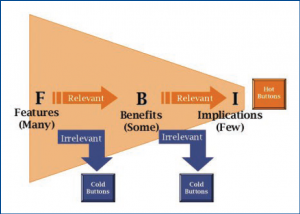“FBI” is an instantly recognisable acronym. To most people it means American law enforcement. To us at GPB it thankfully means something altogether different!
FBI here at GPB stands for “Features, Benefits, and Implications”. Many of us learnt somewhere when trying to win business that you should describe your product or service more in terms of the benefits to the buyer rather than as a list of features. For example, a 5-seater Ford Mondeo has 6 airbags. That’s our Feature but what is the Benefit to a buyer? “Safety?” I hear you say. Yes, that’s the general benefit but the answer would be better defined as “….Better protection for the driver and all passengers, including back seat, and from any direction, not just a head-on collision.” Wordy maybe, but it’s less abstract and more honest. So what’s the Implication? It’s that ultimately the 6 airbags should enable all occupants to live longer and/or continue their lifestyle without permanent disability. Implications get to the ultimate and much more big picture point.
 We find that many clients find it really difficult to do FBI on their own businesses. We have an elegantly simple but very tough (hey we said we’d be your devil’s advocate!) tool to help you, the “So What?” test. Let’s do it on a pitch we hear a lot: “Our firm is truly global”. That’s a feature not a benefit, although the ‘truly’ is a good attempt to suggest competitors aren’t – a differentiator. In addition, a client could easily feel less significant to this big fish.
We find that many clients find it really difficult to do FBI on their own businesses. We have an elegantly simple but very tough (hey we said we’d be your devil’s advocate!) tool to help you, the “So What?” test. Let’s do it on a pitch we hear a lot: “Our firm is truly global”. That’s a feature not a benefit, although the ‘truly’ is a good attempt to suggest competitors aren’t – a differentiator. In addition, a client could easily feel less significant to this big fish.
An improvement comes from asking: “So What?” You might then add “…this would make us ideal partners to your business as we have offices where you do.” This is better but it is still a feature! Better still to state a relevant benefit: “…which means that you will benefit from our valuable local knowledge and so avoid mistakes”. But you can go further still if you think of Implications: “so what that will ultimately do is save you lots of time, money, and particularly hassle”. One more thing – use vivid examples to bring these issues persuasively to life and prevent the problems of abstract language.
That’s FBI, but what are these Hot and Cold Buttons? You hit a Hot Button when you say something particularly interesting and/or persuasive; you may even get a ‘wow’! Hot Buttons are rare, yet can be key moments in a meeting or conversation. Whilst you may get one from a feature, they’re more likely from benefits and implications. You hit a Cold Button whenever you say or do something that puts the client off; something unappealing, irritating or annoying. They turn out to be much more important than Hot Buttons. Let’s suppose our car buyer is a sales rep, who typically drives alone. For them the rear air bags are irrelevant. Promoting rear airbags and their benefits has actually put the buyer off and hit a Cold Button.
It is no use producing a feature and its benefit if the buyer doesn’t find them relevant and attractive. Thus, when putting together your pitch, you have to put together only those features that each buyer will find appealing, and then state (don’t make them guess) the benefits.
All this sounds like common sense and it is. But our experience is that clients are so close to their subject that they find it difficult to focus on benefits and implications. They can’t see the answer from their clients’ point of view. Our advice when preparing is to make a statement and then test it on others with “So What?” Decide whether what you are saying is really a benefit and not just another feature. Will everything you say avoid the Cold and hit those Hot Buttons?

